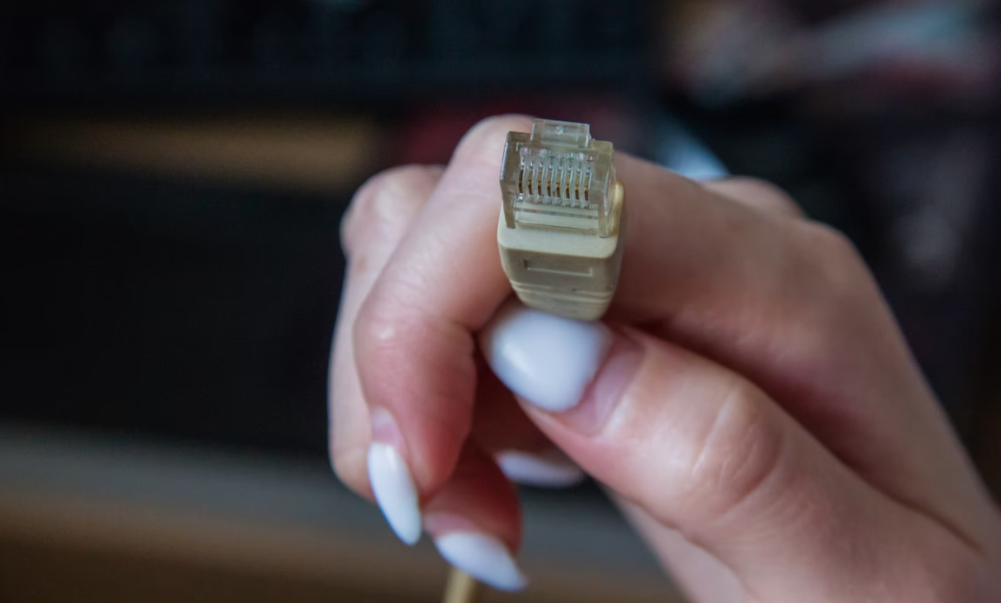There are many types of internet – and they are definitely not created equal! The types of internet you can get at home depend on where you live. Each type uses different technology to bring the web to your devices. Some are fast and reliable. Others are slower or only available in certain areas.

Explore the five most common types of internet and everything you need to know about them. By the end of this article, you’ll be able to choose the best type of internet for you.
Dial-Up Internet
Top speed: 56 Kbps (0.056 Mbps)
Ideal for basic email and very light web browsing
Ideal for modern homes and businesses that require high speeds and ample bandwidth
Dial-up internet was huge in the 1990s and early 2000s. You might remember the screeching connection sounds and waiting for pages to load line by line. You couldn’t use the phone and the internet at the same time. It connects through a standard telephone line, using a modem that “calls” your internet provider. Data travels as sound, then the modem changes it into something your computer can understand.
Today, it’s the slowest type of internet connection still around. In 2023, fewer than 300,000 people in the U.S. used it as their only internet. Almost everyone else has moved to faster broadband internet like DSL, cable, or fiber.

DSL Internet
Top speed: Around 5 Mbps to 100 Mbps
Ideal for: Browsing, HD streaming, and everyday online use
DSL internet became popular in the early 2000s as a big upgrade from dial-up. You could finally use the phone and the internet at the same time. It still uses your telephone line, but it sends digital signals on a different frequency than voice calls. That means no more busy signals while you’re online. Speeds vary based on how far you are from your provider’s central office — the closer you are, the faster it runs.
While DSL is slower than cable or fiber, it’s still a reliable type of broadband internet in many areas, especially where faster options aren’t available.
Cable Internet
Top speed: Around 25 Mbps to 1 Gbps
Ideal for: Streaming, gaming, video calls, and households with many devices
Cable internet became common in many neighborhoods in the mid-2000s. It uses the same coaxial cables that deliver cable TV, so setup is simple if your home already has those lines. Speeds are much faster than DSL and can handle streaming, gaming, and video calls without issues. One drawback is that cable broadband usually has asymmetrical speeds, downloads are much faster than uploads. That can be a problem if you upload large files or livestream.
Because the connection is shared with nearby homes, speeds can also slow down during busy hours. Even so, cable is one of the most common types of home internet in the U.S. and is widely available in cities and suburbs.
Fiber Internet
Top speeds: 100-150 Mbps
Top speed: Around 300 Mbps to 1 Gbps, with some plans up to 10 Gbps
Ideal for: Heavy streaming, online gaming, remote work, and large file uploads
Fiber internet is the fastest type of broadband internet available for homes today. It sends data as pulses of light through cables made of thin glass strands. This allows it to deliver extremely high speeds with low delay. Most fiber plans offer symmetrical speeds, meaning uploads are just as fast as downloads. That’s a big advantage for video calls, livestreaming, and cloud backups.
The downside is limited availability — only certain areas have fiber lines installed. If you can get it where you live, fiber is the most future-proof option for your home internet.
Satellite Internet
Top speed: Around 12 Mbps to 100 Mbps, higher with some low-orbit services
Ideal for rural or remote areas without wired internet options
Satellite internet works by sending your data to a satellite in space and back to a dish at your home. This makes it available almost anywhere, even far from cities or towns. Traditional satellite services have slower speeds and high latency — the delay caused by the signal’s long trip to space. That lag can make video calls, online gaming, and some streaming frustrating. New low-Earth orbit providers, like Starlink, offer faster speeds and lower latency, but service can still be affected by weather. While it’s not the fastest type of home internet, it can be a lifeline in places without cable, fiber, or DSL.

Fixed Wireless and 5G Home Internet
Top speed: Around 25 Mbps to 1 Gbps, depending on technology and location
Ideal for homes without wired options but within range of towers
Fixed wireless internet sends data from a nearby tower to a small antenna or receiver at your home. 5G home internetworks in a similar way but uses the latest cellular networks instead of traditional fixed wireless signals. These services can offer speeds close to cable or even fiber in strong coverage areas. Performance depends on how close you are to the tower and whether the signal is clear. Weather, buildings, and network congestion can slow things down. While not as consistent as wired broadband internet, fixed wireless and 5G can be a solid choice if faster wired options aren’t available.
How to Choose the Right Internet for You
Picking the best type of home internet depends on what’s available, how you use the internet, and your budget.
- Check availability. Use your address to see which providers and connection types you can get. Fiber is best if it’s in your area.
- Think about speed needs. Heavy streaming, online gaming, or remote work benefit from faster plans, ideally fiber internet or high-speed cable.
- Consider uploads. If you share large files or livestream, look for symmetrical speeds. Fiber offers this, while cable and DSL usually don’t.
- Review pricing and limits. Compare monthly costs, contract terms, and any data caps.
- Plan for the future. If you can get fiber now, it will keep up with growing internet demands for years.
| Type of Internet | Availability | Max Speed | Average Price | No Data Caps | Symmetrical Speeds | Reliability |
|---|---|---|---|---|---|---|
| Fiber Internet | Limited (urban/suburban) | 1–10 Gbps | $60–$80 | ✔ | ✔ | ★★★★★ |
| Cable Internet | Widespread in cities/towns | 100 Mbps–1 Gbps | $60–$75 | ✔ | ✘ | ★★★★☆ |
| DSL Internet | Very widespread | 5–100 Mbps | $40–$60 | ✔ | ✘ | ★★★☆☆ |
| Satellite Internet | Nearly everywhere | 12–250 Mbps | $90–$120 | ✘ | ✘ | ★★☆☆☆ |
| Fixed Wireless / 5G Home Internet | Growing coverage | 25 Mbps–1 Gbps | $50–$80 | ✔ | ✘ | ★★★☆☆ |
| Dial-Up Internet | Available anywhere with phone line | 0.056 Mbps | $10–$20 | ✔ | ✘ | ★☆☆☆☆ |
How to Identify Your Current Internet Connection
If you’re not sure what type of internet connection you have, you can check a few simple things:
- Look at the cables.
- Small phone plug: DSL internet
- Thick round coax cable: cable internet
- Slim, clear fiber or ONT box: fiber internet
- Dish on your home: satellite internet
- Antenna or 5G receiver: fixed wireless or 5G home internet
- Run a speed test.
- Very high and equal upload and download speeds usually mean fiber.
- Lower uploads compared to downloads often mean cable.
- Ask your provider. They can confirm the exact connection type.

Best Type of Internet? Fiber Optics!
The types of internet for your home range from older options like dial-up to advanced fiber-optic broadband. The right choice depends on your location, speed needs, and budget. If fiber internet is available where you live, it offers the fastest and most reliable connection for streaming, gaming, and working from home.
At Race Communications, we provide high-speed fiber internet. Enter your address to check availability and see if you can get connected today.
